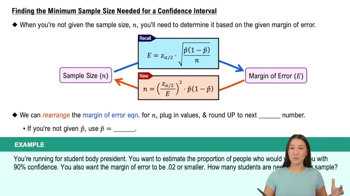Determine the minimum sample size required to be 95% confident that the sample mean waking time is within 10 minutes of the population mean waking time. Use the population standard deviation from Exercise 1.
Table of contents
- 1. Intro to Stats and Collecting Data1h 14m
- 2. Describing Data with Tables and Graphs1h 55m
- 3. Describing Data Numerically2h 5m
- 4. Probability2h 16m
- 5. Binomial Distribution & Discrete Random Variables3h 6m
- 6. Normal Distribution and Continuous Random Variables2h 11m
- 7. Sampling Distributions & Confidence Intervals: Mean3h 23m
- Sampling Distribution of the Sample Mean and Central Limit Theorem19m
- Distribution of Sample Mean - Excel23m
- Introduction to Confidence Intervals15m
- Confidence Intervals for Population Mean1h 18m
- Determining the Minimum Sample Size Required12m
- Finding Probabilities and T Critical Values - Excel28m
- Confidence Intervals for Population Means - Excel25m
- 8. Sampling Distributions & Confidence Intervals: Proportion1h 25m
- 9. Hypothesis Testing for One Sample3h 57m
- 10. Hypothesis Testing for Two Samples4h 50m
- Two Proportions1h 13m
- Two Proportions Hypothesis Test - Excel28m
- Two Means - Unknown, Unequal Variance1h 3m
- Two Means - Unknown Variances Hypothesis Test - Excel12m
- Two Means - Unknown, Equal Variance15m
- Two Means - Unknown, Equal Variances Hypothesis Test - Excel9m
- Two Means - Known Variance12m
- Two Means - Sigma Known Hypothesis Test - Excel21m
- Two Means - Matched Pairs (Dependent Samples)42m
- Matched Pairs Hypothesis Test - Excel12m
- 11. Correlation1h 24m
- 12. Regression1h 50m
- 13. Chi-Square Tests & Goodness of Fit2h 21m
- 14. ANOVA1h 57m
7. Sampling Distributions & Confidence Intervals: Mean
Confidence Intervals for Population Mean
Problem 6.R.16
Textbook Question
In Exercises 13–16, (a) find the margin of error for the values of c, s, and n, and (b) construct the confidence interval for using the t-distribution. Assume the population is normally distributed.
c = 0.99, s = 16.5, n = 20, xbar = 25.2
 Verified step by step guidance
Verified step by step guidance1
Step 1: Identify the given values and understand the problem. Here, c = 0.99 (confidence level), s = 16.5 (sample standard deviation), n = 20 (sample size), and x̄ = 25.2 (sample mean). The goal is to calculate the margin of error and construct the confidence interval using the t-distribution.
Step 2: Determine the critical t-value (t*) for the given confidence level and degrees of freedom (df). The degrees of freedom are calculated as df = n - 1. Use a t-distribution table or statistical software to find t* corresponding to c = 0.99 and df = 19.
Step 3: Calculate the standard error of the mean (SE). The formula for SE is: , where s is the sample standard deviation and n is the sample size.
Step 4: Compute the margin of error (ME). The formula for ME is: , where t* is the critical t-value and SE is the standard error calculated in the previous step.
Step 5: Construct the confidence interval. The formula for the confidence interval is: , where x̄ is the sample mean and ME is the margin of error. Substitute the values to find the lower and upper bounds of the confidence interval.
 Verified video answer for a similar problem:
Verified video answer for a similar problem:This video solution was recommended by our tutors as helpful for the problem above
Video duration:
8mPlay a video:
Was this helpful?
Key Concepts
Here are the essential concepts you must grasp in order to answer the question correctly.
Margin of Error
The margin of error quantifies the uncertainty in a sample estimate. It is calculated using the critical value from the t-distribution, the sample standard deviation, and the sample size. A higher confidence level results in a larger margin of error, indicating a wider range of plausible values for the population parameter.
Recommended video:

Finding the Minimum Sample Size Needed for a Confidence Interval
t-Distribution
The t-distribution is a probability distribution used when estimating population parameters when the sample size is small and the population standard deviation is unknown. It is similar to the normal distribution but has heavier tails, which accounts for the increased variability in smaller samples. As the sample size increases, the t-distribution approaches the normal distribution.
Recommended video:

Critical Values: t-Distribution
Confidence Interval
A confidence interval is a range of values, derived from a sample statistic, that is likely to contain the population parameter with a specified level of confidence. It is constructed by adding and subtracting the margin of error from the sample mean. For example, a 99% confidence interval indicates that if the same sampling process were repeated, 99% of the intervals would contain the true population mean.
Recommended video:

Introduction to Confidence Intervals

 4:48m
4:48mWatch next
Master Population Standard Deviation Known with a bite sized video explanation from Patrick
Start learningRelated Videos
Related Practice
Textbook Question
32
views
